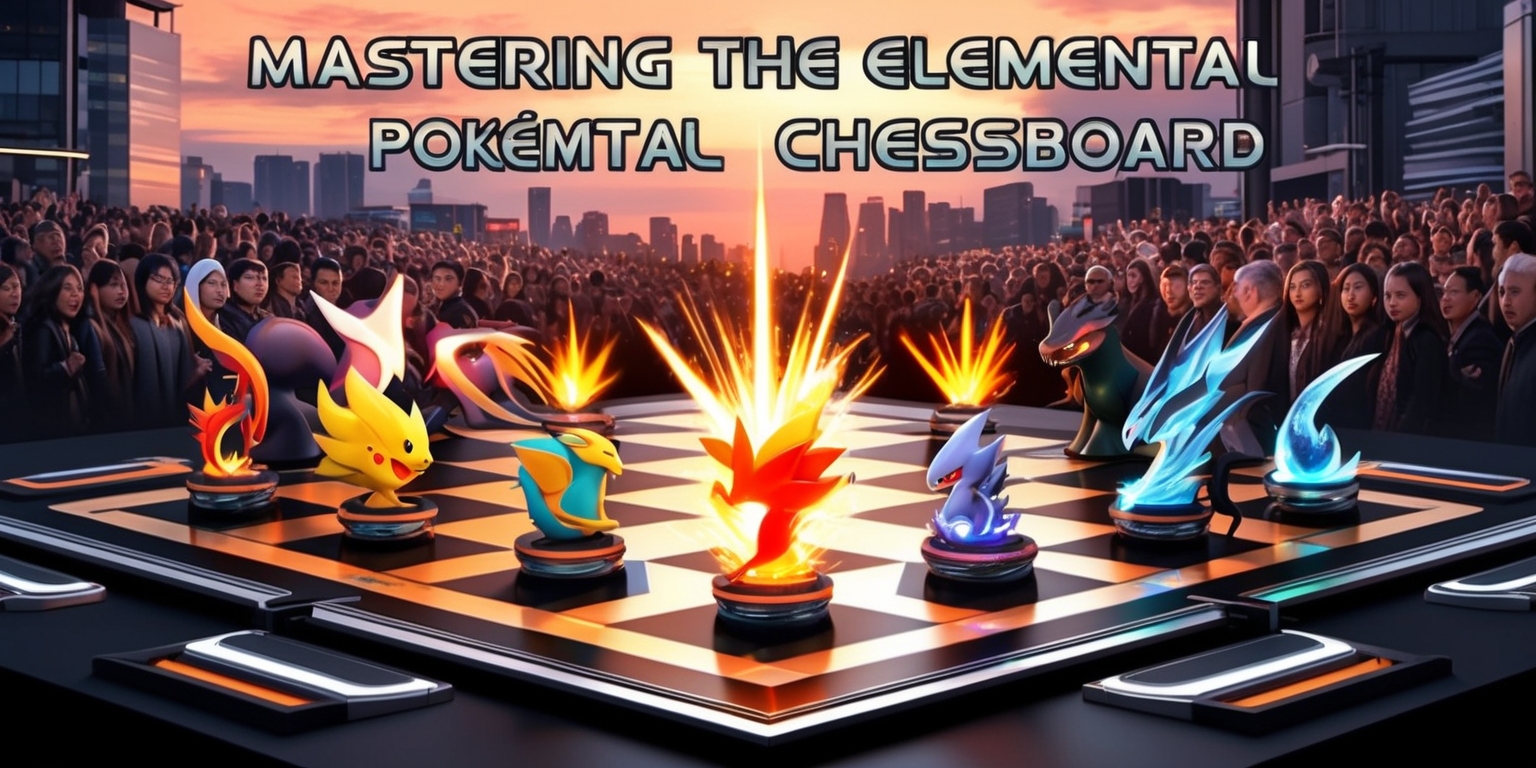Mastering the Elemental Chessboard: A Deep Dive into Pokémon Go Battle Strategies
Aug-02-2025

The world of Pokémon Go is rich with layered strategies and dynamic combat intricacies that captivate both newcomers and veterans alike. At its core lies a system built around elemental types and their interactions, a system that has evolved while still holding true to the same time-tested mechanics present from the outset of the Pokémon series. Whether you are mapping out your battle strategy, planning an event raid, or simply exploring the in-game universe, understanding how these types interact adds an extra dimension to gameplay. The balance between offense and defense, combined with the thoughtful implementation of type advantages and vulnerabilities, ensures that each encounter brings new challenges and decisions, ultimately enriching the overall experience.
Exploring the Intricacies of Type Dynamics
The interaction of Pokémon types in Pokémon Go forms a complex web of strengths and vulnerabilities that mirror a long-standing tradition in the franchise. Each elemental classification—from Fire and Water to Electric and Grass—has its own set of counters and resistances that dictate the flow of battles. Players are encouraged to study these relationships in order to choose moves wisely during combat. The system, reminiscent of a finely balanced strategy game, challenges participants to consider both individual type advantages and the compounded effects when Pokémon possess dual types. With each type carefully calibrated to balance the dynamics among fire, water, and other elements, players can immerse themselves in a rich tactical experience that rewards knowledge and strategic planning.
Mastering the Same Type Attack Bonus
Within the depths of Pokémon Go’s battle mechanics exists the concept of the Same Type Attack Bonus (STAB), which adds a distinct layer of strategy to every encounter. When a Pokémon employs an attack that aligns with its own type, it receives a bonus that bolsters the move's effectiveness. This bonus, though secondary to the elemental matchup system, can turn the tide in a heated confrontation by amplifying damage output at crucial moments. Players who master the art of pairing moves with the appropriate type not only maximize their offensive potential but also refine their ability to predict and counter their opponent’s tactics. The nuanced interplay between STAB and basic type advantages creates a synergistic effect that rewards thoughtful move combinations over brute force.
Diving into Dual-Type Challenges
The complexity of Pokémon battles is further elevated when a creature embodies more than one elemental type. Dual-type Pokémon bring a fascinating twist to the battlefield, as they inherit characteristics from both classifications, which can drastically alter both their strengths and their vulnerabilities. This dual identity means that an incoming attack might have varying degrees of effect based on the intricacies of each type’s properties. Players are often faced with scenarios where an attack may be effective against one type while being mitigated by the second. Understanding these layered interactions is crucial; it transforms battles into rich, engaging puzzles where every matchup requires careful consideration and innovation. This duality emphasizes the need for flexibility and adaptability during combat.
Understanding the Impact of Damage Multipliers

The core mechanics of Pokémon Go rely heavily on damage multipliers that govern how effective an attack will be under different circumstances. These multipliers are integral in determining the outcome of skirmishes on the battlefield. Though the multipliers in Pokémon Go have undergone tweaks compared to their counterparts in the main series, the foundational principles remain intact. Moves that exploit type weaknesses can inflict significantly amplified damage, while other attacks might be reduced in their impact if pitted against a type that naturally resists them. This robust system demands that players remain constantly vigilant about match-ups and adjust their battle approach accordingly. It is a delicate balancing act where every multiplier serves as a guide, informing strategic decisions in real time, and encouraging a deeper engagement with the game’s mechanics.
Deciphering Weaknesses and Strategic Match-Ups
A critical aspect of mastering Pokémon Go lies in the ability to decipher and effectively exploit the weaknesses of various types. Each elemental category possesses specific vulnerabilities that can be leveraged to gain an advantage during battles, prompting players to continuously refine their strategies. Whether facing an opponent with a blend of resilient types or one distinctly focused on exploiting a known weakness, understanding these relationships is paramount. The game challenges trainers to not only select attacks based on raw power but to also consider underlying multipliers and counter-relationships that could influence the battle. This constant analysis of type match-ups fosters an environment where strategic foresight can often eclipse raw strength, and where a keen understanding of weaknesses can become the difference between a triumphant encounter and a missed opportunity.
Charting the Elemental Interactions
Central to the Pokémon Go experience is an extensive chart detailing the elemental interactions that dictate the course of each encounter. This chart, a modern reinterpretation of the classic Rock Paper Scissors system, serves as a crucial resource for trainers looking to fine-tune their tactics. With 18 elemental types to consider, the chart breaks down the specific strengths and challenges posed by each class. Trainers are encouraged to refer to this guide while planning their offensive and defensive maneuvers, ensuring that every move is both intentional and knowledgeable. By understanding which moves are doubly effective when targeting Pokémon with compounded weaknesses, players can better prepare for the evolving challenges of battles. The chart ultimately stands as a living, dynamic reference point, constantly inviting players to explore and master its depths.
Optimizing Combat with Counter Strategies
In addition to understanding the basic mechanics, advanced players often delve into counter strategies designed to optimize each combat encounter. This level of tactical planning involves a deep comprehension of the weaknesses and resistances inherent to specific Pokémon types. By identifying the most effective counters against a given enemy, trainers can adjust their teams and movesets to secure a competitive edge. This strategy extends beyond simply relying on damage multipliers; it It calls for a holistic perspective that takes both into account individual components of a Pokémon’s type and the broader context of team composition during battles. As a result, each combat scenario becomes a sophisticated game of chess, where anticipating an opponent’s next move and adjusting accordingly is as valuable as raw power itself.
The Evolution of Event and Raid Features
The engaging universe of Pokémon Go is continually refreshed by a variety of events and raid features that provide fresh challenges to trainers worldwide. These events, which often revolve around special Pokémon appearances and unique battle quests, are designed to encourage exploration and community collaboration. Whether it is through Adventure Week festivities or the anticipation surrounding new quests like the Gigantamax Journey, each update brings novel ways to interact with the game’s mechanics. Raids and events not only test a trainer’s strategic prowess but also offer opportunities to experiment with different team compositions and game modes such as Max Battles and PokéStop Showcases. This evolving landscape imbues the game with a sense of endless discovery, ensuring that players remain engaged as the community rallies around new in-game challenges.
Exploring Special Categories: Mega and Shadow Forms
Among the myriad choices available to trainers, special categories such as Mega and Shadow Pokémon offer unique advantages and strategic opportunities. These forms are often recognized for their superior combat capabilities and refined stats, making them a coveted asset in battle. Although players might prioritize these enhanced forms when available, the game’s balance design ensures that success is not solely reliant on their presence. Instead, these special variants serve as high-impact tools within a broader strategy, encouraging trainers to make judicious use of their available resources. By carefully incorporating Mega and Shadow Pokémon into their team compositions, players can create synergistic effects that augment their overall combat performance. This strategic dimension further diversifies the gameplay, ensuring that every encounter retains an element of excitement and unpredictability.
Enhancing Engagement through Gameplay Variety
Pokémon Go consistently captivates its audience by showcasing an extensive array of gameplay options and interactive experiences. From competing in the Go Battle League to exploring rare encounters at PokéStops, the game provides multiple avenues for trainers to demonstrate their skills. The diversity in game modes forces players to adapt their strategies, whether they are hunting down elusive species, engaging in cooperative play, or challenging fellow trainers in structured battles. Each mode operates under its own unique set of guidelines and tactical nuances, Ensuring that each session is a unique, one-of-a-kind experience. This constant variability coupled with well-designed combat mechanics creates an ecosystem where players can experience both cerebral challenges and spontaneous fun, further solidifying the enduring appeal of Pokémon Go as a dynamic, multifaceted adventure.







